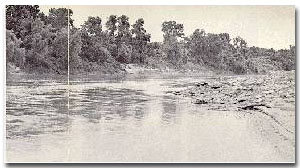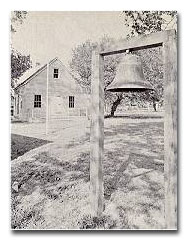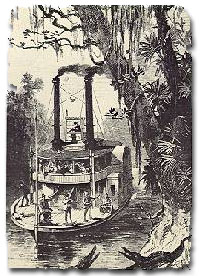FROM A TROUBLED BEGINNING (1836-1839)
 Houston's turbulent beginning was in keeping with the period of Texas history and largely reflected the conflicts that existed throughout the United States.
Houston's turbulent beginning was in keeping with the period of Texas history and largely reflected the conflicts that existed throughout the United States.
How Houston came to write its name across the nation in steel rails and concrete roads and inland waterways, as well as around the world in the smoke from steamer stacks and in the contrails of sky-riding jets, makes an exciting story of extraordinary achievement.
While Mexico was breaking away from Spain in the early 1800s, restless people from throughout the older states headed for the southwest in search of adventure and opportunity. Within a few years, the Americans out numbered the Mexican settlers in Texas, and by the early 1830s there was talk about independence. The Mexican government sought by harsh measures to maintain control, but in 1835 the Texans rebelled. If this revolt of Texas against Mexico had merely marked the transition from one political connection to another, it would have been an event of no slight historical significance. But its broader importance was found in the influence it was to have on the making of two nations--the United States and Mexico.
This site was important to how the Battle of San Jacinto turned out. Santa Anna left much of his army here to loot and burn while he marched off looking for Sam Houston's Army. He found it-and defeat.
Texas declared its independence on March 2nd, 1836, but was not immediately successful in its efforts to get the United States to recognize it as a Republic. The Battle of the Alamo on March 6th unified the people of the Republic, and then on April 21st, Texas independence was established when the Texan army under General Sam Houston defeated the Mexican army under Santa Anna at the Battle of San Jacinto. Of this Battle Charles Edward Lester wrote:
"On that well-fought field, Texan independence was won. A brave but outraged people, in imitation of their fathers of the century before, had entrusted their cause to the adjudication of battle, and had gained the victory. It was not a struggle for the aggrandizement of some military chieftain, nor was it a strife for the empire. The soldiers who marched under the 'Lone Star' into that engagement were free, brave, self-relying men. Some of them, indeed, had come from a neighboring Republic, as Lafayette crossed the sea to join the struggle for freedom, but most of them were men who cultivated the soil they fought on, and had paid for it with their money or their labor. Hundreds of them had abandoned their homes to achieve everlasting freedom for their children. They were fighting for all that makes life worth living or gives value to its possession."
Only a few months before the Battle of San Jacinto, riots had broken out at an anti-slavery society meeting in New York City, and pro-slavery rioting erupted in Philadelphia with about 40 homes in the Black community being destroyed. In Boston a mob was angered by the preaching of William Loyd Garrison, the noted abolitionist, "that all men are created equal...," and he was lodged in jail overnight for his safety. Growing urbanization of American life was blamed by "The People's Magazine" for the creation of a new type of young man, "unhealthy, badly postured, pale and nervous." The Rev. Charles Giles, preaching in support of the temperance movement, declared that 56,000 people were destroyed each year in the United States by drink and that "500,000 drunkards are now living in our blessed America, all moving onward to the dreadful verge."
 Undaunted by the circumstances of the times, two New York real estate promoters, J. K. and A. C. Allen, started a search for a location where they could begin building "a great center of government and commerce." In August, 1836, they bought 6,642 acres of land, without any improvements on it, from Mrs. T. F. L. Parrot, the widow of John Austin, near the head of tidewater on Buffalo Bayou for $9,428. Out of their admiration for the hero of San Jacinto, and anticipation his election as the first President of the Republic of Texas, the Allen brothers named their dream city for Sam Houston. In the hope that their city would be selected as the Capital of Texas, just one week before Houston's election, they advertised that "Nature seems to have designated this place for the future seat of government."
Undaunted by the circumstances of the times, two New York real estate promoters, J. K. and A. C. Allen, started a search for a location where they could begin building "a great center of government and commerce." In August, 1836, they bought 6,642 acres of land, without any improvements on it, from Mrs. T. F. L. Parrot, the widow of John Austin, near the head of tidewater on Buffalo Bayou for $9,428. Out of their admiration for the hero of San Jacinto, and anticipation his election as the first President of the Republic of Texas, the Allen brothers named their dream city for Sam Houston. In the hope that their city would be selected as the Capital of Texas, just one week before Houston's election, they advertised that "Nature seems to have designated this place for the future seat of government."
Foresight was exercised in the early steps to build Houston, when Gail Borden, Jr., publisher and surveyor, laid out its streets eighty feet wide, with Texas Avenue, the principal east-west street, one hundred feet in width. Hailing Houston a city "handsome and beautifully elevated, salubrious and well-watered, and now in the very heart and center of population," the Allen brothers persuaded the first Congress of the Republic of Texas, with inducements of government buildings and private lodgings for Congressmen, to select Houston as the capital. Although President Houston found only one small log cabin and a dozen people here in January, 1837, another visitor only two months later said of the town that "persons came pouring in until, in a short time, a floating population had collected some four or five hundred people."
The Republic of Texas was soon recognized by the United States and a number of European countries, but Mexico continued to threaten invasion and Indian hostilities continued another menace. However, Houston showed promise of making progress toward the bright future envisioned by its founders. With Congress in session, and the Texas army disbanded late in 1837, the community was experiencing boom conditions.
The excitement of the period, however, lost to Houston its first industrial prospect. A local businessman had persuaded his uncle to come from New Jersey to consider locating a carriage manufacturing establishment here. However, after gun shots were exchanged during a session of the Congress that he was visiting, he rushed out to have a soldier who had been shot in a saloon almost fall upon him, and a short time later another man with his bowels protruding from a Bowie knife wound staggered into him. He promptly left Texas, never to return.
During this period, Houston was making slow but substantial progress. In January, 1837, the Laura became the first steamship ever to visit Houston, and Galveston, reported this event:
 "The Laura had plied the waters of the Brazos under Captain Grayson. The Laura's initial trip up Buffalo Bayou marked the official opening of that stream to Houston via steamship travel. The most noted passenger on that first trip was Frank Lubbock (later a distinguished governor of Texas) who affords a highly amusing account of the voyage - proceeding upstream from Clopper's Bar (now Morgan's Point), the Laura's first stop was at Harrisburg. It required three days for the little steamer to make the trip from Harrisburg to Houston, because of frequent stops to cut down overhanging trees or blow up log-jams."
"The Laura had plied the waters of the Brazos under Captain Grayson. The Laura's initial trip up Buffalo Bayou marked the official opening of that stream to Houston via steamship travel. The most noted passenger on that first trip was Frank Lubbock (later a distinguished governor of Texas) who affords a highly amusing account of the voyage - proceeding upstream from Clopper's Bar (now Morgan's Point), the Laura's first stop was at Harrisburg. It required three days for the little steamer to make the trip from Harrisburg to Houston, because of frequent stops to cut down overhanging trees or blow up log-jams."
Lawlessness, epidemics and financial problems prompted the people of the community to attempt some improvements of the conditions under which they were living. A few of them had some knowledge of organizations called Chambers of Commerce. It was agreed by many that a Chamber of Commerce was needed to work out Houston's problems, and Senator Robert Wilson, who represented the local district, introduced a bill in the Congress of the Republic on November 26, 1838, to charter the Houston Chamber of Commerce. Action on the proposal was delayed by the expulsion of Senator Wilson from Congress on January 7, 1839; and by the emergency adjournment of the Congress on January 11th, when a mob broke up the session with a demonstration following the almost unanimous re-election of Senator Wilson.
The journals of both houses of the Third Congress, which met in December, 1838, and in January, 1839, revealed that the bill for the chartering of the Houston Chamber of Commerce was under consideration. The senate journals for December 27,1838, reported that "a bill to establish a Chamber of Commerce in the city of Houston; passed." In the house journal for Friday, January 11, 1839, the reporter noted that a message had been received from the senate listing acts approved by that body; and among these, "...an act establishing a Chamber of Commerce in the city of Houston" had passed the senate and asked the immediate concurrence of the house. However, the matter did not become official until January 28,1840, when President Mirabeau B. Lamar signed the act of incorporation.
By that time, the problems that plagued the village had become acute. At the end of 1839, ten percent of the population of Houston had died from recurring epidemics of yellow fever, and although the germ-killing bitter winter of 1839-1840 had slowed its incidence, another violent outbreak was expected with the return of warm weather. In the meantime, the New Orleans suppliers had cut off the credit on which Houston merchants had been depending. The Republic's "redback" currency first dropped to 50 cents on the United States dollar, then on down to 25 cents, and finally to 10 cents. On January 14, 1839, President Lamar had approved a bill moving the capital of the Republic to Austin, or what was then called "Waterloo." Governmental business continued at the Capital Building in Houston until the latter part of 1839. As a matter of fact, the act of 1836 provided that the capital would be located in Houston until the end of the legislative session of 1840. However, in October, the archives and furniture were loaded into wagons for the journey to Austin, and a small sign appeared in a bare window of the Capital: "For lease to responsible parties." A couple of weeks later, the Allen brothers used the columns of the "Houston Morning Star," Texas' first daily newspaper, to advertise the Capitol for rent, and it was rented in less than a month.






